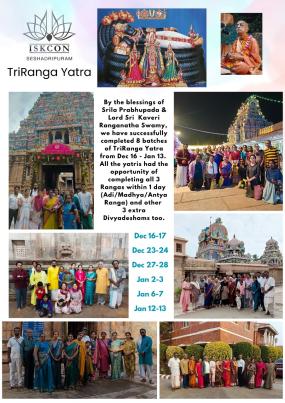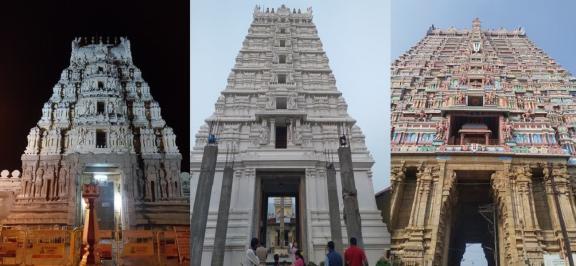Pilgrimage Holidays | Tour Packages from Bengaluru
Vaishnavas consider the Triranga Darshanam as most valuable and significance when done between the Sunrise and sunset.
TriRanga means visiting 3 Ranganatha temples. The 3 Ranganatha temples are Adi Ranga, Madhya Ranga and Anthya Ranga. Adi Ranga is the Sri Ranganatha Swamy at Srirangapatna, Madhya Ranga is the Sri Jaganmohana Swamy at Shivanasamudra and Antya Ranga is the Sri Ranganatha of Srirangam at Trichinapalli/Tirchy.
This darshan is termed 'Brahmanda Darshanam' by many and it is believed that this relieves people of various malefic effects of planets.
Adi Ranga
This temple dedicated to Lord Vishnu is in the Mandya Dt of Karnataka. This is the first of the three Sri Ranganatha swami temples on a island formed by the river Kaveri.The Lord is in the Anantha Sayanam Pose, smiling at devotees and showering His profound blessings to the true devotee. Dated back to the ninth century AD this temple attracts devotees from all over the country. Saint Ramanuja stayed here for a long time . The temple is well maintained and the daily rituals are performed as per the rules laid in scriptures.

Madhya Ranga
Sri Ranganathaswamy is called as "Madhya Ranga". The God is in reclining posture as found in Srirangam and Srirangapatnam. It is said that the God here represents 'Youth' and hence also called as "Mohana Ranga".
The story behind how Shivanasamudra got its name has many versions. According to one, it is said that one day, Shiva and Parvathi were on a stroll in the sky and were observing the river Kaveri from above. Shiva observed that a huge rock obstructed the increasing ongoing flow of the river. But the river spread out like an ocean and surrounding that rock, flowed forward. Amazed by the sheer size of the river, which appeared to him as an ocean, Shiva proclaimed "Dhanya Kaveri" (Blessed river). Observing the ocean like river which impressed Shiva, Parvathi gave it the name "Shivanasamudra". All the temples have been built on the same rock which is famous today as Shivana Samudra.
Another version says Devendra who was affected from "Vruthra Hathya", was doing penance in several holy places. As per the instructions of Sri Brahma, he formed a beautiful Ranganatha Swany idol, a form of Vishnu, and started worshipping him here. One day, the water flow increased rapidly and started flooding the place. Concerned that his penance might be disturbed, Devendra, smashed a portion of the huge rock that this place was and made way for the river to flow ahead from either side of the rock. The river plummetted down with a lot of force from the right of the rock. This came to be known as the "Bharachukki" waterfall. From the left, it took a more steady approach to the cliff before diving down. This came to be known as the "Gaganachukki" waterfall. Devendra is said to have successfully completed his pooja and achieved expiation against his sin. Since the rock was smashed by Devendra, this place also got the name "Shila Bhedhana Kshetra".
The ancient Sri Someshwara Temple is another famous temple here at Shivanasamudra. Adi guru Sri Shankaracharya is said to visited this place and has established a "Sri Chakra" in this place. Surprisingly, it is believed that the Someshwara Linga here is said to have been existing much before the Ranganantha Idol and that the Saptarshis were performing pooja and worshipping this Linga.
The Shakthi Devathe temple of Vanadurga Devi is 1 Km away from the Someshwara temple. The goddess is also fondly worshipped by the name "Varaprasadi". Large number of devotees throng this place every Tuesday and nowadays Fridays and Sundays also attract more number of devotees. Just before Ugadi every year, annual festival is celebrated here.
Antya Ranga
Sriramgam temple is dedicated to Lord Ranganatha, who lies on His side reclining on a giant snake. Srirangam is one of the 108 divya deshams or temples dedicated to Lord Vishnu. It is in the tentative UNESCO heritage list.
This temple has as many as 21 gopurams built in 7 concentric circles. 7 circles are called Sapta prakarams. These walls enclose as many as 9 pushkarini or water pools, over 50 shrines and over 35 pavilions. It also has a 1000 pillar mandapam. The temple itself is built on an island formed by the rivers Kaveri and Kollidam. These outer gopurams can be seen from far off distance.
The outer two prakarams or courtyards are used for commercial purposes now. They house shops, residential buildings, flower shops and eateries.
The innermost prakaram is where Lord Ranganatha can be found reclining on the Adishesha or the 5 headed snake. He lies on his side. The Lord is beautiful to look at with His sweet smile. The vigraha is quite big too.
Of course where there is Vishnu, you will find Lakshmi. Here Lord Ranganatha is blessing His devotees along with Goddess Tayaru also called Ranganayaki. Her shrine is quite a distance from His.
In fact, this temple is so large that you need to be ready to walk a lot. The walk from the outer most to all the shrines is quite long and winding. If you stop to pray at various other shrines inside dedicated to other forms of Lord Vishnu like Rama, Gopal Krishna etc, and all the beautiful mandapas or pavilions, then you can be sure that your steps for the day will be definitely done!
The architecture of the temple is very beautiful. The sculptures and the attention to detail on them are so awesome to look at.
It was built by Chola kings in the 13th century. It has been rebuilt many times since because of damages from muslim invaders and floods from the surrounding rivers. The rebuilding has been done by Cholas, Nayakas and Vijayanagar empires. Their influences are clearly seen in the structures.
- Dhanur Maasa Darshan
- 3 Rangas
- 3 Divya Darshnas
- 2 Temples
Approx Amount – Rs.4,500/- + GST
Mode - Tempo Traveller
Month - December, January
No of days - 3 Days
Includes
- Darshan Entry Tickets
- Saatvik Breakfast, Lunch, Dinner & Snacks
- Sharing Accommodation
Extra Charges For
- Private Auto
- Single Occupancy Rooms
- Any other charges not mentioned in the inclusions
NOTE
* As fares and date may fluctuate depending on availability, please call the numbers below to get the most accurate price and dates.
Important points to be considered by the devotees in the Yatra
- Devotees should be punctual in their reporting time and Group leaders are to ensure that others are not delayed by the delay of few devotees. Every day the Yatra will leave as scheduled and will not wait for late comers.
- Devotees should stay together and not plan any thing separate from the Yatra.
- All Devotees are assigned to a group leader and they should report to their group leader for all matters.
- Separate timing will be given for purchases/ shopping and devotees should not go here and there for purchases.
- Devotees should bring their own lock with multiple keys and the Yatra management does not hold responsibility for any loss of baggage.
- Devotees should carry their essentials like medicine, water bottle, ropes for drying clothes etc.
- Please carry your chanting beads and a Vaishnava song book.
- Please actively participate in kirtans.
- Devotees are requested to carry some emergency food for old aged and children for emergency though Prasadam is arranged for all on all the Yatra days.
- Devotees are suggested to carry their notebook and pen for taking notes during the Yatra.
- The best way to relish the Yatra is to hear from senior devotees about the glories of the Lord and his pastimes.
- Devotees should bring their original identity card (aadhar) and submit as and when requested.
- Devotees should not offend any Dham vasis by arguing or quarrelling with them.
- No one should enter a pond or a river for bathing without the permission of the group leader.
- Devotees should not throw garbage and should keep the Dham clean and also keep silence.
- Devotees are requested to travel light particularly those travelling by flight. The allowed baggage allowance is 15 Kgs for check in and 7 Kgs for cabin.
- Please check the weather details online and carry clothes accordingly.
- Devotees are requested to come in Vaishnava dress that is Dhoti and Kurta for Prabhujis and Saree for Matajis during temple visits.
- Devotees are requested to not carry any expensive items like jewellery, iPads etc.
- Aged devotees, women and children to be given first priority and their needs to be attended on priority.
- As far as possible, requesting yatris to not consume outside food.
- Do not travel if there are any serious health issues.
- Life members can carry LPM (life patron cards).
For book please Call or Whatsapp.
Information for travellers
- All the above yatras are subject to change according to time, place & circumstance.
- Mentioned prices are subject to change according to the current situation of Govt budget & inflation.
- Pure South Indian food will be provided for all yatras(Cooks will accompany us) if the total no of participants are more than 20.
- Customized trips can be arranged if no of people are more than 20.
- All Yatras inclusive of Flight/ Train charges, Food & Stay.
